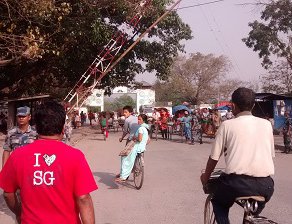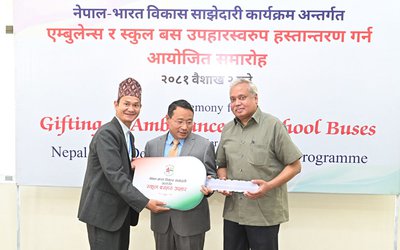
The uniqueness of Nepal-India open border is that millions of people go cross it every single day. Even herds of cattle and wild animals walk past this over 1,600 kilometers border. In effect, Nepal-India open border is a life line for those living on either side. However, academic and expert discourses of the capitals of both the countries discard the relevance and significant of Nepal-India open border. Although some unwanted incidents by certain miscreants cannot be rule out, people from both the sides generally maintain a tranquil surrounding as the masses move past the open border
Puran Chaudhary, a resident of Kakarvitta (Nepal) , is worried about the three days’ closure of Nepal-India border for the elections going to be held in India. Chaudhary is not alone in expressing such worries. Vishow Majumdar, 32, from Naxalbadi India shares a similar feeling. Majumdar, who owns and operates a Tata Sumo, depends on the income from transporting Nepalese crossing the border for earning a living.
Puran fetches all kinds of household necessities from the Indian town. The closure of the border may create shortages of the daily necessities. “We find it much easier to buy goods in the Indian side as they are cheaper,” said Chaudhari.
Vishow is concerned about whiling away his time until the vote. “After casting vote, I won’t have to wait for two more days to start helping in the movement of the people again,” said Majumdar.
According to the Nepalese Police Post in Kakarvitta, the movement of people is enormous. Their estimate is over 20,000 people cross the point everyday between 7 AM and 7 PM.
For many, this is the lifeline. The number of local people crossing the border is much higher than the travelers and outsiders doing so. As the people living on both sides of the border may have marriage relations across the border, some visits are more frequent than others.
With the growing reports of misuse of the open border, the number of security personnel deployed on either side, keeping a greater vigilance, has been common. The extra vigil harms the interests of the people living in the border areas more often than those who could really be involved in illegal acts.
“We share pain, happiness and joy together. We live in harmony and friendship,” said Chaudhary. “An overwhelming majority of the people are living in peace and harmony and those involved in illegal acts are outsiders.”
Security obstructions created on both sides of the border are causing a havoc in the routine livelihood of tens of thousands of people like Majumdar and Chaudhary. Their survival and prosperity depend on the tranquility and development of the border areas.
Along with these people, herds of wild elephants cross the border, leaving from one place and going to another in India and Nepal. The passage of wild elephants used to be the dense forests from Brahmaputra valley of Upper Assam to Nepal’s Kosi. The forests have been cleared in several places by the people for their settlement, inviting intensified conflict between man and wild animal.
Cooperation between the forest and wild life officials of the two countries are dragged in to avert the man-animal conflict. Unlike human beings who can change the road, elephants follow the same track for years.
Although they work for two different governments, security agencies maintain a close cooperation between them to maintain the order. All work to contain unwanted activities that can disrupt the life of peoples living on both sides of the border and even the wild animals.
However, their pattern of living is changing. The people living in the border areas are facing a lot of hassles from the security forces. As the academic and security related debates rent the air in the seminar halls of the capital of both the countries, the people living in the border areas face all the hassles.
For example, people living in the eastern border point Jogbani have closer relations than any other parts of Nepal-India open border. Most people living on both sides don’t remember the need to show their identity until the security personnel deployed in the border areas demand their identification.
“Despite all odd situations, we maintain our close relations with the people living in this or other side,” said Shyam Sunder Gupta, a shop owner of Jogbani, India.
At another eastern regional border point at Kaptangunj in Sunsari, farmers from both sides of the border send each other’s cattle across it. The modern state’s intervention is creating a lot of hurdles in the centuries old man to man relations alongside the line separating India and Nepal.
“Although border security personnel are creating a lot of problems for cattle grazing by stopping the herds of cattle passing the border, people still share and continue their practices. You cannot identify the cattle on the basis of their color,” said a resident of Kaptangunj, on condition of anonymity.
Nepal India border remains open all the time. Anyone entering Kathmandu Valley has to get a rahadani or visa from the district governor. However, the border of southern plains remain open and there is no restriction for the movement of people.
“None of the treaties between Nepal and India ever mention the procedures for the regulation of the Nepal-India border. The trade agreement has specified the agreed routes for mutual trade. But there is no agreement regarding movement of the people and the agreed routes for movement of people of both countries along the border. As for trade, there are 22 agreed transit and customs posts along the Nepal-India border. The concept of open border between Nepal and India has still remained an enigma. Besides, there are several sub-customs posts. It is alleged that it is possible to have illegal movement of people and goods in collaboration with personnel deputed in those posts. There is no denying the fact that it is not unusual from the practical point of view to have illegal smuggling of goods, trafficking of girls to brothels in Indian cities, trafficking in narcotic drugs, arms and ammunition and movement of criminals and terrorists. In principle, both Nepal and India have positively agreed to control such illegal activities along the border, but there is lack of an effective and practical approach. So far as smuggling from Nepal to India is concerned,” writes Vidya Bir Singh Kansakar, Professor and former Head, Central Department of Geography, in his paper Nepal-India Open Border: Prospects, Problems and Challenges, presented in a seminar organized by Friedrich Ebert Stiftung in 2001.
According to Kansakar, there are exit/entry points and the travelers and the people of both the frontiers must cross the border from these crossing-points. But there should never be the closed border system between Nepal and India, as there is an age old relationship not only in the government level but also in the people to people level.
Kansakar writes, “before the signing of the Sugauli Treaty between Nepal and India and subsequent demarcation of the Nepal India boundary, there existed free and unrestricted movement of people of Nepal and India across the border. It was almost impossible to control and regulate the movement of people along hundreds of kilometres of border.
Nepal-India border is unique in the world in the sense that people of both the countries can cross it from any point, despite the existence of border check posts at several locations. The number of check posts meant for carrying out bilateral trade is 22. However, only at six transit points out of them, the movement was permitted to nationals of third countries, who require entry and exit visa to cross the border.
It is not known how the system of free movement of people on either side of the border continued even after the delineation and demarcation of Nepal-India border after 1816. The security officials on both the sides claim that they are not going to restrict the local residents. Our priority is containing organised smuggling. Listen to the local people: the situation is different, as people living on either side of the border have piles of complaints to make.
Indian academician Pushpita Das writes in her article that there is the need to effectively manage the India-Nepal border. “The open border between India and Nepal not only addressed mutual security considerations but also fostered close socio-economic relations between the two countries. The unrestricted flow of people over the years has resulted in the dissemination of ideas, culture, and settlements of people in each other’s territory, thereby strengthening the bilateral social and cultural relations. The open border also has a favorable impact on two economies,” writes Das. “While it is true that the open border has facilitated terrorist and criminal activities that are adversely impacting national security, it is equally important to recognize that an open border has also helped India and Nepal to develop and deepen socio-cultural and economic relations.”
However, there are strong views prevailing in capital Kathmandu, like in Indian capital New Delhi, to close the border. “If we have a look back on the border management system between Nepal and India, anyone entering into, Nepal particularly to the Kathmandu valley and towns of Tarai in general, had to get Rahadani or visa from the district administrations. We need to revise such a system. The border must close,” said Buddhi Narayan Shrestha.
“Current open and unrestricted border system between Nepal and India has created so many adverse impacts and it has given rise to many problems. Cross-border crimes, criminal activities such as murder, theft, and rape cases have increased in both the countries due to the open border.”
In whatever terminologies the academicians and security experts may have to describe about Nepal-India open border, the open border has economically benefited the nationals inhabiting both sides of the border. The increasing urbanization and growth of towns in the Tarai and along the border inside Nepal and India has resulted in large inflows of goods from Indian side into Nepal. The open border has provided employment to the people on both sides in the transport as well as other sectors.
Although the debate over Nepal-India open border has done good for academic exercises in the capital of both the countries, such debates will only be meaningful it they understand the heart and minds of the people living for centuries across the border.

Keshab Poudel
Poudel is the editor of New Spotlight Magazine.
- ECONOMY: Growth At 3.3
- Apr 16, 2024
- DPM’s SHRESTHA’S CHINA VISIT High Profile, Low Key
- Apr 14, 2024
- Maha Kumbha In Barahkshetra: A Sacred Festival In Sacred Koshi (Kaushiki) River
- Apr 09, 2024
- LOSS AND DAMAGE: Upper Tamakoshi A Case
- Apr 02, 2024
- Helvetas-Nepal’s InElam Promoting Herbal Oil In Sarlahi
- Mar 31, 2024
















